

6 Scaffolding Strategies to Use With Your Students. What’s the opposite of scaffolding a lesson? Saying to students, “Read this nine-page science article, write a detailed essay on the topic it explores, and turn it in by Wednesday.” Yikes! No safety net, no parachute—they’re just left to their own devices. Let’s start by agreeing that scaffolding a lesson and differentiating instruction are two different things. Scaffolding is breaking up the learning into chunks and providing a tool, or structure, with each chunk. Simply put, scaffolding is what you do first with kids. Scaffolding and differentiation do have something in common, though. So let’s get to some scaffolding strategies you may or may not have tried yet. 1. How many of us say that we learn best by seeing something rather than hearing about it? Try a fishbowl activity, where a small group in the center is circled by the rest of the class; the group in the middle, or fishbowl, engages in an activity, modeling how it’s done for the larger group.
Multiple Intelligences: What Does the Research Say? Many educators have had the experience of not being able to reach some students until presenting the information in a completely different way or providing new options for student expression. Perhaps it was a student who struggled with writing until the teacher provided the option to create a graphic story, which blossomed into a beautiful and complex narrative. Or maybe it was a student who just couldn't seem to grasp fractions, until he created them by separating oranges into slices. Because of these kinds of experiences, the theory of multiple intelligences resonates with many educators. It supports what we all know to be true: A one-size-fits-all approach to education will invariably leave some students behind. However, the theory is also often misunderstood, which can lead to it being used interchangeably with learning styles or applying it in ways that can limit student potential.
Howard Gardner's Eight Intelligences The Difference Between Multiple Intelligences and Learning Styles. Using Differentiation in Science to Teach Every Student. At the Beginning of a Unit Differentiation in science starts at the beginning of each unit.
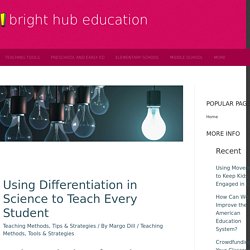
Before you begin teaching a unit on space, plants, rocks and minerals, or so on, give your students a pre-test to see what information they already know. For example, if one of your science objectives is to teach students the names and order of the planets, then you can ask this question on a pre-test. If half of your class already knows this information, then here’s an objective you can use for differentiation. This way, students who already know this information can learn something else about planets, and those who do not can work on mastering the objective. Some teachers give formal pre-tests before each unit; some lead class discussions and make observations about which students are answering questions correctly.
Differentiation Is Just Too Difficult: Myth-Busting DI Part 3. What if you could predict the winning numbers to the biggest prize of a major lottery?
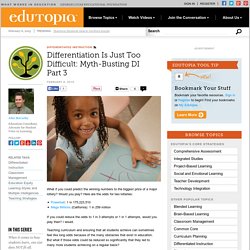
Would you play? Here are the odds for two lotteries: There's No Time to Differentiate: Myth-Busting DI, Part 2. The microwave oven is a great timesaver for getting any food on the table.
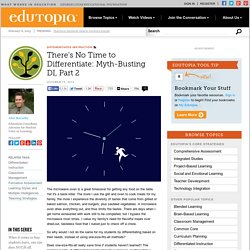
Yet it's a taste killer. The more I use the grill and oven to cook meals for my family, the more I experience the diversity of tastes that come from grilled or baked salmon, chicken, and burgers, plus sautéed vegetables. A microwave oven dries everything out, and thus limits the tastes. There are days when I get home exhausted with work still to be completed, but I bypass the microwave most times. 6 Strategies for Differentiated Instruction in Project-Based Learning. Project-based learning (PBL) naturally lends itself to differentiated instruction. By design, it is student-centered, student-driven, and gives space for teachers to meet the needs of students in a variety of ways. PBL can allow for effective differentiation in assessment as well as daily management and instruction. PBL experts will tell you this, but I often hear teachers ask for real examples, specifics to help them contextualize what it "looks like" in the classroom.
We all need to try out specific ideas and strategies to get our brains working in a different context. Here are some specific differentiation strategies to use during a PBL project. 1. We all know that heterogeneous grouping works, but sometimes homogenous grouping can be an effective way to differentiate in a project. 2. Reflection is an essential component of PBL. 3. This is probably one of my favorites. 4. Differentiated instruction in science. I am a science specialist and I teach students in first through fifth grades.
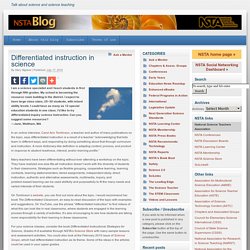
My school is becoming the resource room building in the district. I expect to have large class sizes, 25–30 students, with mixed ability levels. I could have as many as 12 special education students in one class. I’d like to try differentiated inquiry science instruction. Can you suggest some resources? In an online interview, Carol Ann Tomlinson, a teacher and author of many publications on the topic, says differentiated instruction is a result of a teacher “acknowledging that kids learn in different ways, and responding by doing something about that through curriculum and instruction.
Many teachers have been differentiating without ever attending a workshop on the topic. On Tomlinson’s website, you can find out more about the topic. How to Make a Rubric for Differentiation. Rubrics are "rules" or a way to explicitly lay out expectations for an assignment, and the means to evaluate or grade an assignment using a point system.
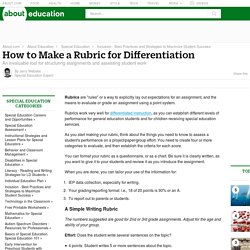
Rubrics work very well for differentiated instruction, as you can establish different levels of performance for general education students and for children receiving special education services.